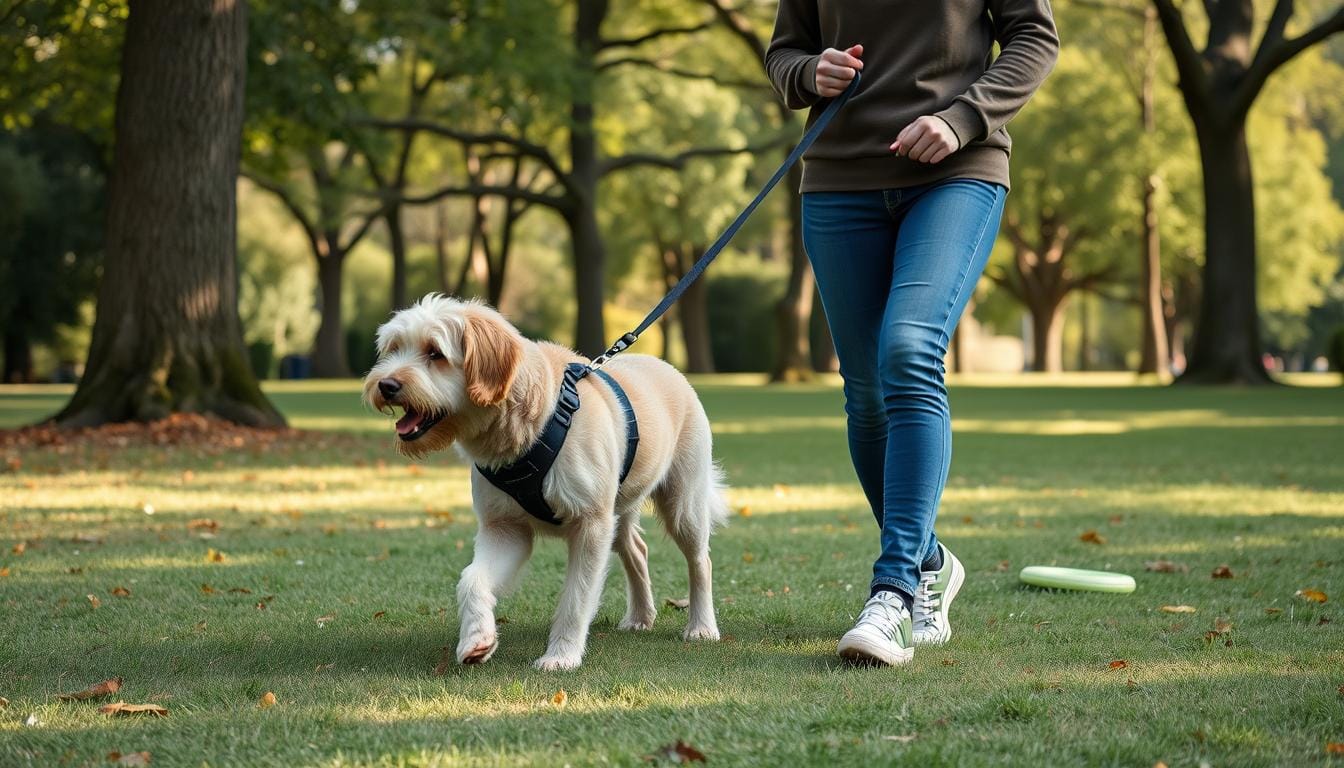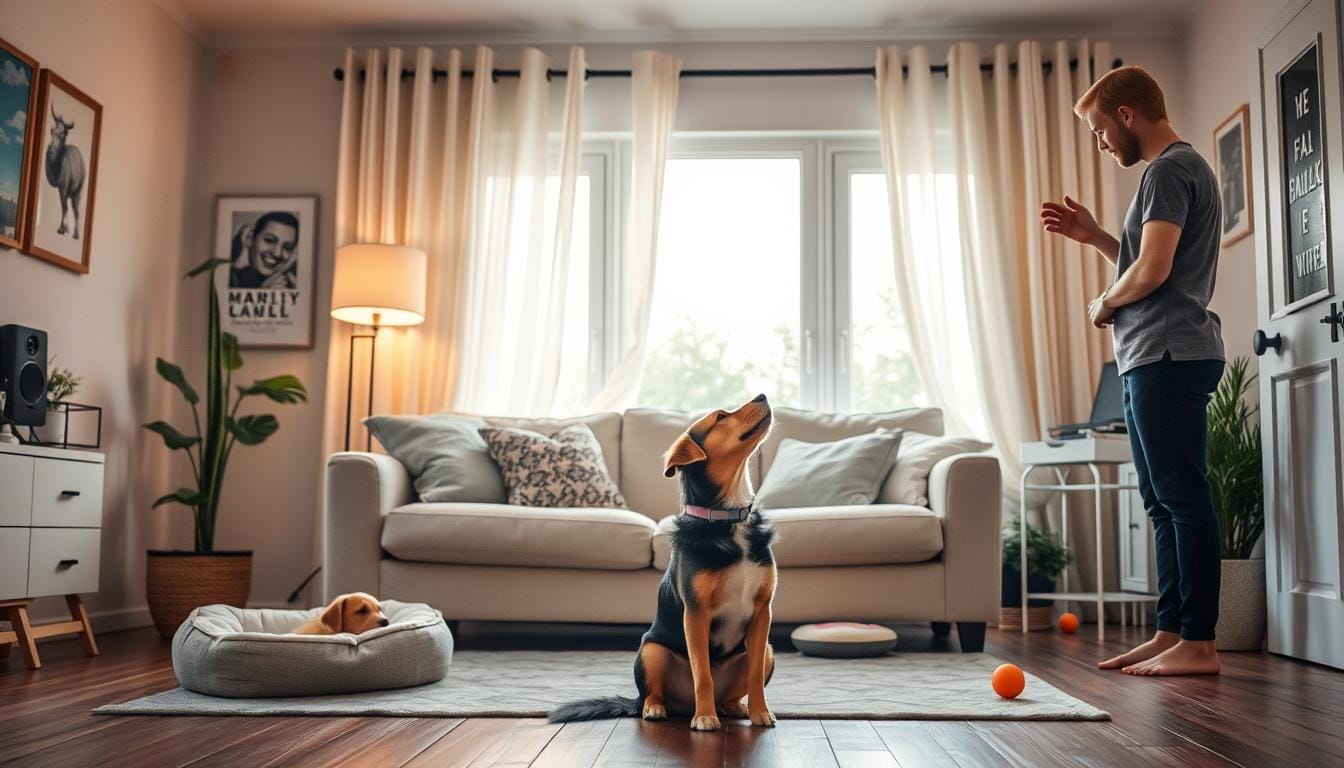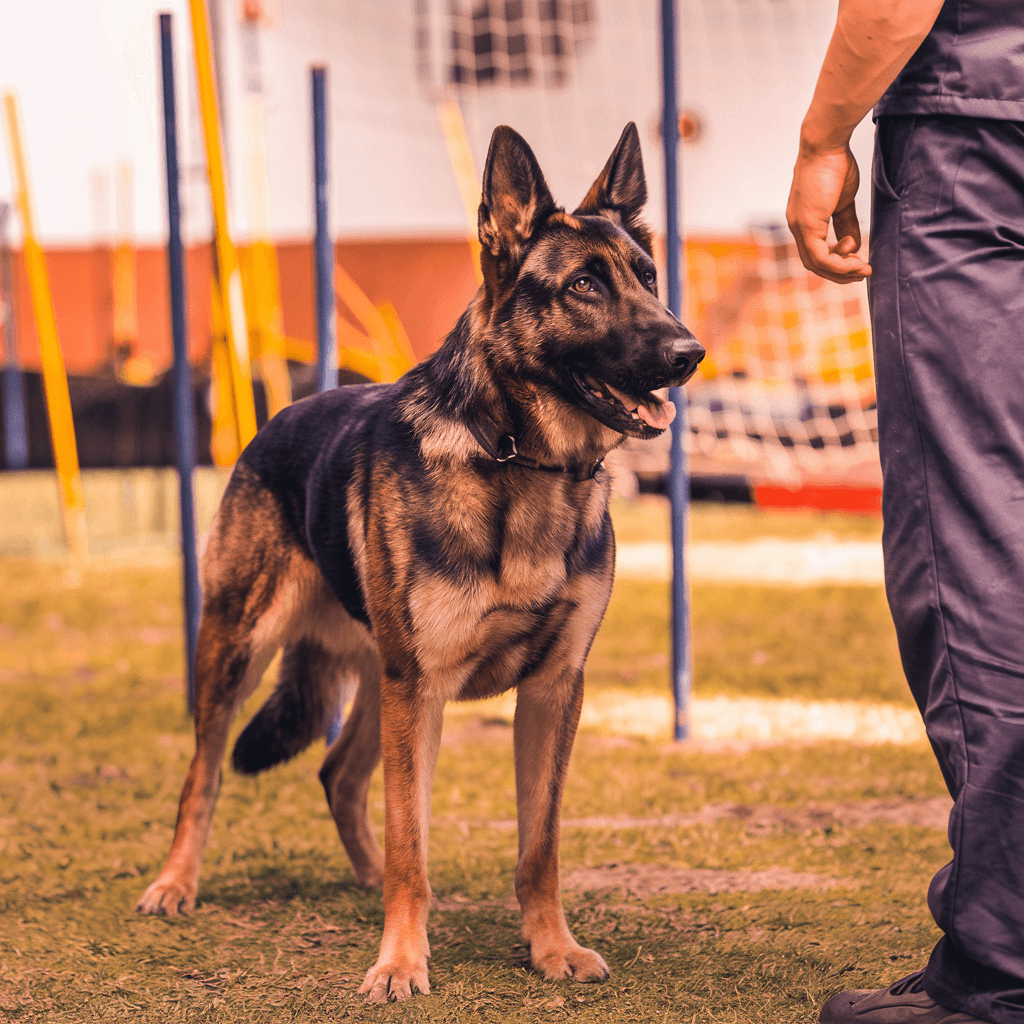Is your dog’s constant barking driving you crazy? We get it. Excessive barking can be frustrating for pet owners and neighbors alike. But don’t worry – there are effective ways to calm your dog and reduce this noisy behavior. Let’s dive into some proven dog training techniques to help you achieve peace and quiet in your home.
Barking is a natural form of communication for dogs, but it can become problematic when it’s excessive. Understanding why dogs bark is crucial for choosing the right behavior correction methods. By using positive reinforcement and consistent training, we can teach our furry friends when it’s appropriate to bark and when to stay quiet.
In this guide, we’ll explore various strategies to stop dog barking and create a calmer environment for both you and your pet. From prevention techniques to professional training options, we’ve got you covered with solutions for excessive barking that really work.
Key Takeaways
- Understand the root causes of your dog’s barking
- Use positive reinforcement to encourage quiet behavior
- Establish consistent training routines with all family members
- Provide adequate exercise and mental stimulation
- Consider professional help for persistent barking issues
- Avoid punitive methods that can worsen behavior
Understanding Why Dogs Bark: Common Triggers and Causes
Dogs bark to communicate. Knowing why they bark helps us use bark control methods better. Each bark has its own reason and sound.
Territorial and Alarm Barking
Dogs bark loudly when they feel their territory is threatened. This is their way of warning others. About 70-85% of dog owners see this as a good way to protect their pets.
Attention-Seeking and Greeting Barks
Dogs bark to get treats or play. They learn this from getting rewards for barking. When they see people or other dogs, they bark with excitement or calmness. Knowing these reasons helps in dog obedience training.
Frustration and Compulsive Barking
Dogs bark when they’re frustrated or can’t move. Compulsive barking, affecting 10-15% of dogs, is when they bark a lot without reason. Both need special canine noise management methods.
| Barking Type | Cause | Management Approach |
|---|---|---|
| Territorial | Perceived threats | Desensitization training |
| Attention-seeking | Desire for rewards | Ignore unwanted behavior |
| Compulsive | Anxiety or stress | Behavioral therapy |
By finding out why dogs bark, we can train them better. This makes them happier and quieter.
Stop dog barking, dog training techniques, calm dog, behavior correction
Many dog owners face the problem of excessive barking. It can be really frustrating. But, there are effective training methods to help your dog be calmer. Positive reinforcement is a key part of these techniques.

To start, understand why your dog barks. The American Society for the Prevention of Cruelty to Animals lists several reasons. These include territorial, alarm, attention-seeking, and greeting barking. Knowing the reason helps you find the right solution.
Teaching your puppy not to bark starts early. Training sessions should be short, about 10-15 minutes. Begin with the “Speak” command, which most dogs learn in an hour. This is the first step to teaching the “Quiet” command.
- Remove visual or auditory stimuli that trigger barking
- Provide mental and physical stimulation
- Use positive reinforcement to reward quiet behavior
- Gradually reduce treat rewards to reinforce training
Being consistent is important in training your dog. Repeat the training several times a day for a week. If problems continue, get help from a certified dog trainer or a vet behaviorist.
“Patience and persistence in training are crucial. Dogs show improvement over time in responding to commands, such as taking less time to quiet down when given the ‘Quiet’ command.”
Every dog is different. Think about your pet’s personality and temperament when choosing how to manage barking. With the right approach and techniques, you can make your home a peaceful place for both you and your dog.
The Power of Prevention: Setting Your Dog Up for Success
Preventing excessive barking starts with creating a calm environment. By using calm demeanor coaching, we can help our dogs succeed and reduce unwanted barking.
Creating a Calm Environment
To reduce barking triggers, try these strategies:
- Close blinds to block visual stimuli like squirrels
- Use white noise machines to mask outside sounds
- Create designated quiet zones in your home
Exercise and Mental Stimulation
A tired dog is less likely to bark a lot. Add these activities to your dog’s routine:
- Daily walks or runs
- Interactive puzzle toys
- Training sessions for mental engagement
Establishing Daily Routines
Consistent schedules help reduce anxiety-related barking. Set regular times for:
- Meals
- Walks
- Playtime
- Quiet time
These preventive measures can greatly reduce barking. Studies show that 100% feedback for prevention before a dog reacts can change behavior in two weeks. Also, at least six “noisy” training sessions can condition a new emotional response.
| Prevention Method | Effectiveness | Time to See Results |
|---|---|---|
| Closing blinds | High | 1-2 weeks |
| White noise machines | Medium | 2-3 weeks |
| Consistent routines | High | 3-4 weeks |
| Mental stimulation | Very High | 1-2 weeks |
By focusing on these preventive strategies and dog obedience training, we can effectively address excessive barking. This creates a harmonious living environment for dogs and their owners.
Positive Reinforcement Training Methods
Positive reinforcement is a strong way to train dogs. It rewards good behaviors, like stopping barking. We use treats, praise, or toys to make our dogs want to do it again.
Timing is everything in positive reinforcement. Give rewards right after the good behavior. This helps your dog learn fast. Being consistent with cues and rewards is also important.
Here are some top positive reinforcement techniques:
- Use short verbal cues like “sit” or “quiet” with physical gestures
- Reward incrementally as your dog progresses towards the desired behavior
- Vary reward frequency to maintain engagement
- Choose small, soft treats for effective training
Studies show dogs trained this way are more social and learn better. It not only fixes bad habits but also makes your bond stronger.
| Training Method | Benefits | Best For |
|---|---|---|
| Continuous Reinforcement | Effective for new behaviors | Initial training stages |
| Intermittent Reinforcement | Maintains learned behaviors | Advanced training |
| Shaping | Teaches complex behaviors | Gradual behavior modification |
Training dogs takes patience. If you’re having trouble, get help from a certified trainer. They know all about positive reinforcement.
Teaching the “Quiet” Command: Step-by-Step Guide
Learning the “quiet” command is key in dog training. We’ll show you how to use this method to keep your dog calm.
Starting with the “Speak” Command
First, teach your dog to bark on command. Use something like a doorbell to make them bark. Say “speak” and use a hand signal. Don’t praise them for barking. Keep practicing until they bark when you say “speak.”
Transitioning to “Quiet”
After your dog learns “speak,” start teaching “quiet.” Wait for them to stop barking, then say “quiet” and give a treat. As they get better, wait longer before giving them a treat. This teaches them that being quiet is good.
Reinforcement Techniques
Being consistent is important in dog training. Train in short sessions every day. Don’t give treats as often as you start. Remember, training a dog takes time and patience.
| Training Step | Duration | Frequency |
|---|---|---|
| “Speak” Command | 5-10 minutes | 2-3 times daily |
| “Quiet” Command | 5-10 minutes | 2-3 times daily |
| Reinforcement | Throughout the day | As needed |
By following these steps, you’ll help your dog become calmer and more obedient. Every dog learns at their own pace. So, be patient and keep training regularly.
Desensitization and Counter-Conditioning Strategies
Effective dog behavior modification often involves desensitization and counter-conditioning techniques. These strategies are key in addressing excessive barking and promoting a calm demeanor in our canine companions.

Desensitization involves gradually exposing dogs to triggers that cause barking. We start with low-intensity stimuli and slowly increase exposure over time. This process can take months, especially for dogs with long-standing negative associations.
Counter-conditioning pairs these triggers with positive experiences. For example, when a cyclist approaches, we reward the dog for staying calm. This changes the emotional response to the stimulus, transforming it from a cause for alarm into a cue for treats.
- Practice sessions should occur at least twice weekly
- Sessions may last 5 to 45 minutes
- Daily practice yields better results
For optimal results, we keep dogs below their emotional threshold during training. This ensures the effectiveness of our excessive barking solutions. Genetics play a role in a dog’s temperament, so some may require more intensive calm demeanor coaching.
“Patience and consistency are crucial in behavior modification. The process can take hours, weeks, or even months depending on the dog’s emotional response.”
While these techniques are powerful, complex cases may benefit from professional help. A trained behaviorist can tailor strategies to your dog’s specific needs, ensuring the best outcome for your pup’s behavior modification journey.
Using Anti-Barking Tools and Devices
Anti-barking devices are key in managing dog noise. They help create a calm environment and cut down on excessive barking. Let’s look at some effective options.
Citronella Collars and Spray Deterrents
Spray collars release citronella when a dog barks. This sudden burst interrupts the barking. Regular refills keep them working well. Studies show these collars can reduce barking by up to 88% in some cases.
Anxiety Wraps and Calming Aids
Anxiety wraps apply gentle pressure, like swaddling a baby. This can help reduce stress and stop anxiety-induced barking. Pheromone-based collars also work for some dogs, mimicking natural calming signals.
Sound Masking Devices
White noise machines or fans can block external noises that trigger barking. These devices create a constant sound. This helps keep your dog calm and less reactive to outside stimuli.
| Device Type | How It Works | Effectiveness |
|---|---|---|
| Citronella Collar | Sprays citronella when dog barks | Up to 88% reduction in barking |
| Anxiety Wrap | Applies gentle pressure | Reduces stress-induced barking |
| Sound Masking | Blocks external noise triggers | Decreases reactivity to outside stimuli |
Remember, these devices work best with consistent training and positive reinforcement. Always talk to a professional trainer or vet before adding new tools to your dog’s routine.
Professional Training and When to Seek Help
When dog training doesn’t work, it’s time to get professional help. The AKC GoodDog Helpline, celebrating its tenth year in 2023, shows the need for expert advice. Professional trainers can tackle tough issues like anxiety-induced barking, which affects 75% of dogs who bark at windows.
Certified Professional Dog Trainers offer specialized help for barking problems. They use positive reinforcement, which is 2.5 times more effective than punishment. These experts also provide enriching activities for 60% of dogs who bark instead.
Get professional help if your dog’s barking is due to separation anxiety or aggression. Studies show 65% of dogs respond better to commands with proper training. A pro can create a program for your dog’s needs, leading to lasting behavior changes.
- Look for trainers who use positive, humane methods
- Avoid those advocating harsh or punitive techniques
- Consider intensive training programs or regular sessions with at-home practice
Seeking professional help isn’t a failure. It’s a step towards a happier, well-behaved dog. With expert advice, you can solve the root of excessive barking and enhance your dog’s life.
Conclusion
Stopping excessive dog barking is a journey that needs patience and understanding. We’ve looked at many ways to calm dogs and fix this issue. Techniques like positive reinforcement and desensitization can really help.
Barking is natural for dogs. We want to manage too much barking but still let them communicate. With regular training and changes in their environment, we can find a balance. This makes our dogs calmer and our homes more peaceful.
If simple training doesn’t work, it’s okay to get professional help. Dog behaviorists can offer specific solutions for tough barking problems. By finding and fixing the causes and using the right methods, we can stop dog barking. This way, we can have a better relationship with our furry friends.
















